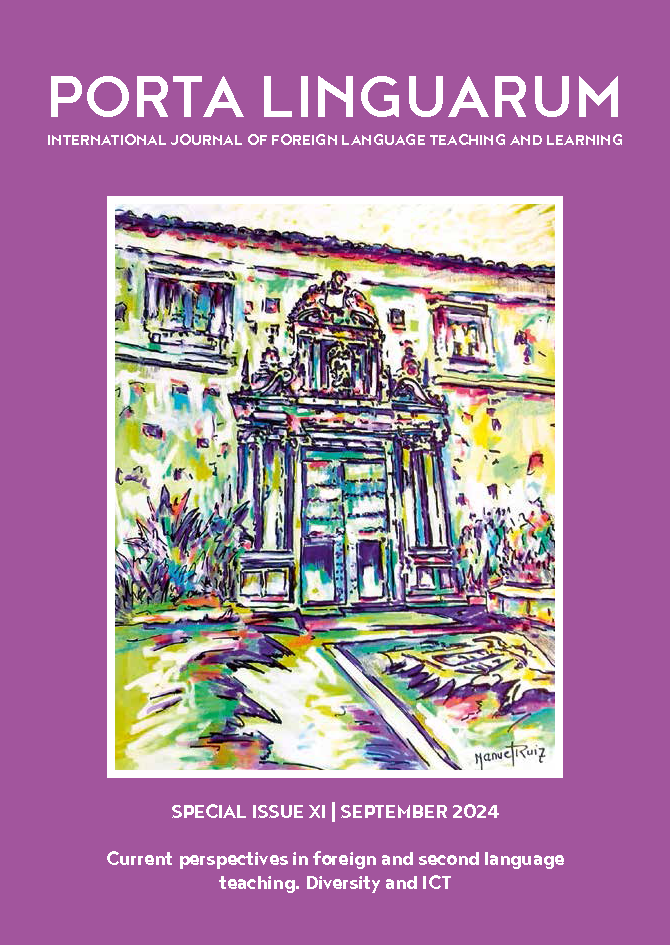Teaching practices of Spanish as a second language in the private school of Charlotte Christian, North Carolina - USA
DOI:
https://doi.org/10.30827/portalin.viXI.30306Keywords:
Teaching Spanish as a second language, Learning, Play-Based learning, Participatory Action, Teaching PracticesAbstract
This article presents the results of an investigation that proposed to transform the practices of teaching Spanish as a second language, basic level, in the private school of Charlotte Christian; in Charlotte, North Carolina through the implementation of didactic strategies with a playful approach. For this, a qualitative methodology was used, with a Participatory Action Research (IAP) design. The data search was carried out with the TELL Project instrument. The participants were teachers who are in charge of Spanish courses as a second language in this school. Among the most relevant results, it stands out that the learning objectives of the lessons are rarely communicated so that students understand what they will learn and can play an active role in the construction of their learning, added to this, given the passive and receptive attitude of the students, a teacher-centered pedagogical practice is configured with few real communication scenarios that imply the use of the Spanish language. The foregoing demands a process of reconstruction of teaching practices that starts from reflection, contextualization and playfulness, as proposed in the present investigation.
Downloads
References
ACTFL.(2006). ACTFL Performance Guidelines for K-12 Learners. American Council on the Teaching of Foreign Languages. Yonkers.
American Council on the Teaching of Foreign Languages. (2023). ACTFL | Facilitate Target Language Use. ACTFL. https://bit.ly/3TQIHlD
Anderson, L. W., & Krathwohl, D. R. (2001). A taxonomy for learning, teaching, and assessing: A revision of Bloom’s taxonomy of educational objectives (1st ed.). Longman.
Ariza, E., Yahya, N., Zainuddin, H., & Morales-Jones, C. A. (2015). Fundamentals of teaching English to speakers of other languages in K-12 mainstream classrooms /|cEileen Whelan Ariza, Noorchaya Yahya, Hanizah Zainuddin, Carem A. Morales-Jones. (4th ed., pp. 92–105). Kendall Hunt Publishing Company.
Bransford, J. D., Brown, A. L., & Cocking, R. R. (2000). How people learn: Brain, mind, experience, and school. California State University Northridge; Washington, DC: National Academy Press. https://bit.ly/3rvtTLK
Campanario, J. M. (2002). ¿Cómo influye la motivación en el aprendizaje de las ciencias? www2.uah.es/imc/webens/127
Dai Hounsell, D. (2003). Student feedback, learning and development. In Higher Education and the Lifecourse (pp. 67–78). Buckingham: SRHE & Open University Press. https://bit.ly/3EOzOTW
Dahlberg, C. (2021). Foreign Language Education - Proficiency, Standards, Assessment, Technology, Support for Foreign Language Teachers, Elementary School Foreign Language Programs. Education.stateuniversity.com. https://bit.ly/3qvilHf
Dinham, S. (2007). How Schools Get Moving and Keep Improving: Leadership for Teacher Learning, Student Success and School Renewal. Australian Journal of Education, 51(3), 263–275. https://doi.org/10.1177/000494410705100304
Downing, J., & Peckham-Hardin, K. (2001). Daily schedules: A helpful learning tool. Teaching Exceptional Children, 33(3), 62–68.
Drexel University School of Education. (2020, August 3). The Importance of Diversity in the Classroom. Drexel. https://bit.ly/3U3HJ5z
Fink, L.D. (2003) Creating significant learning experiences: An integrated approach to designing college courses. Jossey-Bass, San Francisco.
Gardner, M. (2019, August 21). The Benefits of Sharing Our Planning With Students. Edutopia. https://edut.to/2jYlqBE
Glavin, C. (2014). Audio-Lingual Method, K12 Academics. https://bit.ly/3qwZVps
Harari, Y. N. (2019). 21 Lessons For The 21St Century. Penguin Random House.
Hernández, F. (2000). Los métodos de enseñanza de lenguas y las teorías de aprendizaje. Revista de investigación e innovación en la clase de idiomas. Vol. 22, No. 11, p. 141.153.
Jiménez, C. (1998). Pedagogía de la Creatividad y de la Lúdica. Colección mesa redonda. Cooperativa Editorial Magisterio
Krashen, S. D. (1987). Principles and practice in second language acquisition. Phoenix Elt.
Lamon, M., Halpern, D., Donaghey, B. y Brewer, W. (2021). Learning Theory - Constructivist Approach, Schema Theory - Historical Overview. Education.stateuniversity.com. https://bit.ly/3qtW24G
Leif, J. y Brunelle, L. (1978). La Verdadera Naturaleza del Juego. Editorial Kapelusz.
Lewis, N. (2015). Daily agendas: The key to organizing the classroom. Journal on Best Teaching Practice, 2(1), 7–9.
Loveless, B. (2022). Lifelong Learning: A Complete Guide. Www.educationcorner.com; Education Corner. https://bit.ly/3VDtF2X
Mack, N., Woodsong, C., Family Health International, United States. Agency For International Development, MacQueen, K. M., Guest, G., & Namey, E. (2005). Qualitative research methods : a data collector’s field guide. Family Health International. https://bit.ly/3BaFBkT
McKechnie, L. E. F. (2008). Observational research. In Given, L. M. (Ed.), The Sage encyclopedia of qualitative research methods (pp. 573–577). Thousand Oaks, CA: Sage.
Montessori, N. y Newson, J. (2004). El juego didáctico como estrategia de enseñanza aprendizaje ¿cómo crearlo en el aula? Universidad Pedagógica Experimental Libertador.
National Foreign Language Center. (2015). TELL Project. Teacher Effectiveness for Language Learning. http://www.tellproject.org/
Oficina de Medición de la Calidad de los Aprendizajes. (2016). La importancia de la retroalimentación en el proceso de evaluación | UMC | Oficina de Medición de la Calidad de los Aprendizajes. Peru: Ministerio de Educación.
Pérez, M. y Barreto, A. (2012). Metodología para la enseñanza y aprendizaje del español como lengua extranjera. IFRN Editora.
Royal Society of Chemistry. (n.d.). Sharing objectives | Principles of assessment for learning. RSC Education. https://rsc.li/3TmfZr4
Santos Rego, M. A. (2009). Estructuras de Aprendizaje y Métodos Cooperativos en Educación. Revista Española de Pedagogía, 185, 53–78. https://rb.gy/18wy3
Sanuy, C. (1998) Enseñar a jugar. Marsiega.
Shefatya, S. y Smilansky, L. (1990). A médium for promoting cognitive, socio emotional and. Psychological & Educational Publications.
Thamarana, S. (2015). A Critical Overview of Communicative Language Teaching. International Journal of English Language, Literature and Humanities. Vol. 3, No. 5, p. 90–100. https://bit.ly/35YL2mg
Thomas, S. (1992). The implications of translation theories for language teaching pedagogy. https://bit.ly/2TpDqXf



















